Watering your houseplants can be overwhelming.
You’ve probably heard that fiddle leaf figs are hard to grow or finicky, which in large part is due to their specific watering requirements. If you water your plant too much (which is pretty common), you will kill it. If you don’t water enough, it will suffer. What’s a plant owner to do?
Diagnose: Is Your Plant Getting Too Much or Too Little Water?
If you’re confused about whether your plant has been getting too much or too little water, there are some surefire ways to tell.
First, ask yourself the following questions about over-watering:
- Do you water more than once a week? If so, your plant is probably over-watered.
- Is the soil wet to the touch one inch below the surface? Stick your finger in and find out. If so, over-watering is likely. (Make sure to use a well-draining potting soil like this.)
- Do your plant’s leaves have dark spots or edges? This could signify too much water.
- Are their flies or a musty smell in your plant’s soil? Too much water is the culprit.
Now ask yourself the following questions about under-watering:
- Are the newest leaves smaller than the existing leaves? They may be lacking water or nutrients for growth.
- Is your plant dropping leaves? This can be caused by low humidity or thirst.
- Is the top inch of soil very dry? Your plant may be thirsty.
- Are the edges of your plant’s leaves yellow or brown? They may be dry.
If after answering these questions you’re still not sure whether you’re over- or under-watering your plant, read more about the symptoms to tell the difference.
However, because plant owners who worry about their plants a lot tend to over-water, you are probably over-watering. If you’re reading this article, you obviously care about your plant, so it’s likely you are watering too much rather than too little. A moisture meter is an essential tool to keep you in the know regarding your plant’s thirst.
How Often You Should Water
The best thing you can do for your plant’s health is to water like clockwork and never let it dry out completely to the point that you see soil shrinkage, where the soil pulls away from the sides of the pot.
Soil shrinkage is a big problem, because the next time you water, the water runs between the soil and the pot down the sides and doesn’t actually get to the roots of your plant. The vicious cycle of erratic watering (alternating between over- and under-watering) can lead to the death of your plant.
The good news is that there’s a foolproof way to water your fiddle leaf fig plant just the right amount: they only need to be watered once a week!
Set a calendar reminder to water your plant no more than once a week.
If you stick with your once-a-week schedule, your plant will get used to the conditions and really thrive. The best part about watering your plant once a week is that it will give you the confidence to know you’re not over- or under-watering your plant. Now you don’t have to second-guess yourself or worry!
Of course, this schedule will only work if your plant has proper drainage.
Make sure your plant is potted properly and drains completely after each watering. To check, insert a wooden skewer to the bottom of the pot and make sure it’s not wet before you water. (A moisture meter can be a big help here!) If the soil is wet a week after you watered last, you need to improve your drainage in a hurry. (You may need to repot your plant.)
How Much You Should Water
You don’t need to drench your plant to give it enough water.
To keep things simple, water your plant the same amount each week.
For plants that measure less than 2 feet from the soil to the tallest leaves, water 1 cup each week. For plants that are greater than 2 feet tall, water with 2 cups of water each week. If your plant is between 3 and 6 feet tall, use 3 cups of water. More than 6 feet tall? Water with 4 cups of water each week or just until your container drains.
Never let your plant sit in water, and make sure your container fully drains each time you water.
The Best Water for your Fiddle Leaf Fig
fig leavesDid you know that the type of water you use can drastically affect the way your plant grows? Some types of water contain chemicals that may result in brown spots or browning edges of your fiddle leaf fig leaves. Most tap water systems contain chemicals (chlorine and fluoride), which can affect the health of your plant. Watch the video above and learn more about the most common chemicals in water, the best water pH levels, which water is best for your fiddle leaf fig, and the best water temperature to use.
Feed Your Plant
Your plant works hard during its growing season (spring and summer), which means it will be putting a lot of resources toward growing new branches and leaves. Just like humans need the proper fuel to replenish our bodies, to support a healthy plant, it’s critical to provide proper nutrition.
Use a diluted liquid fertilizer each time you water (every week) in the spring and summer and every other time you water in the fall. Try a liquid house plant fertilizer or Fiddle Leaf Fig Plant Food for best results.
Fiddle Leaf Fig Plant Food is specially formulated to provide the optimal nutrition for your plant and comes with instructions for how to properly feed your plant. Order your one-year supply of Fiddle Leaf Fig Plant Food online today.
What Are the Next Steps?
- To help with watering your fiddle leaf fig tree, read all about how to use a moisture meter to know when to water your fiddle leaf fig.
- Protect your houseplant from insects, bacteria, and fungus with our Houseplant Leaf Armor. (As an added bonus, the Leaf Armor also cleans and adds shine to your houseplant’s leaves!)
- To learn more, sign up for our free Fiddle Leaf Fig Care 101 Webinar for advanced fiddle leaf fig care.
- Subscribe to our newsletter.
- Read The Fiddle Leaf Fig Expert, your complete guide to growing healthy fiddle leaf fig plants. The book is available in full-color paperback or Kindle edition on Amazon now!
- Click to join our community on Facebook: Fiddle Leaf Fig Plant Resource Group.


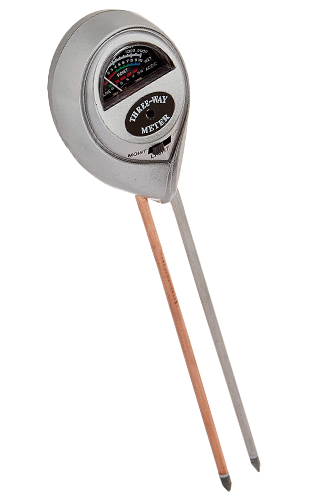
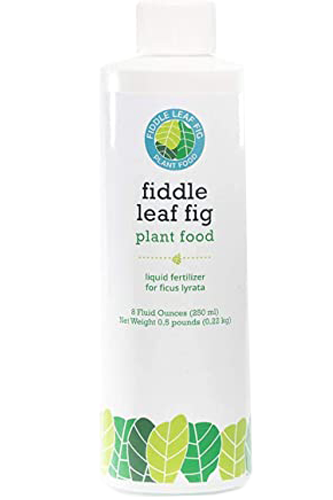
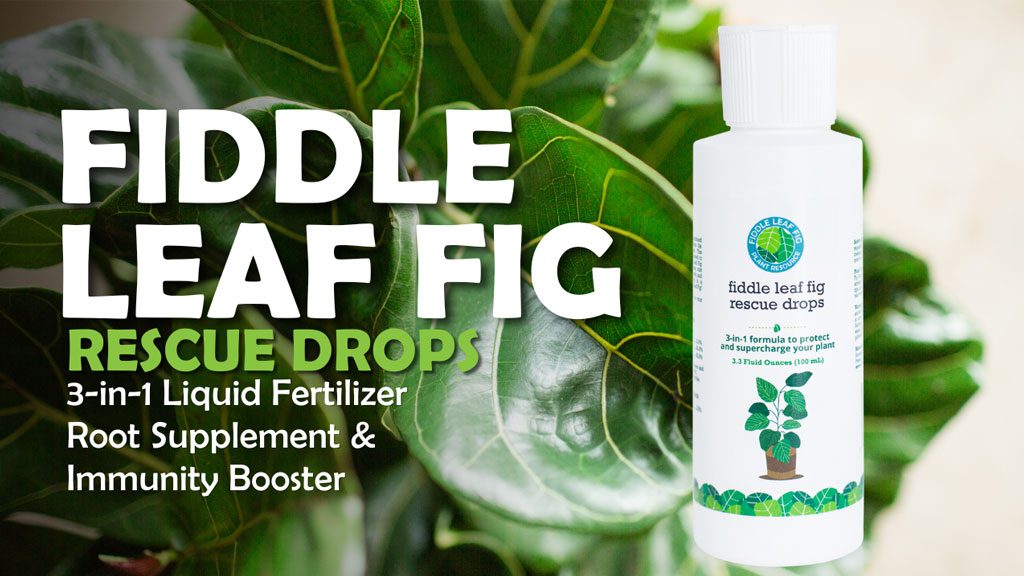




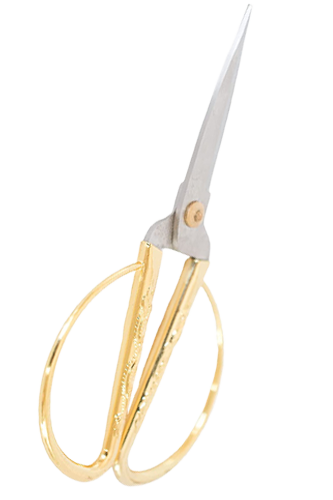



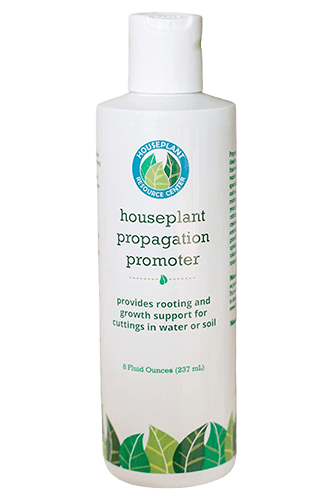

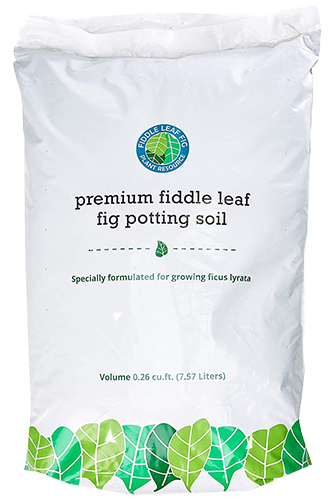


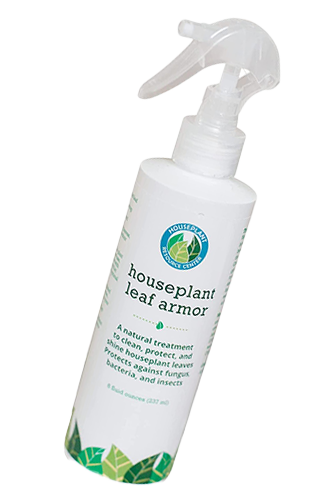
I purchased my FLF at almost 6′ tall for a showhouse event but when the company delivered it to my job site I saw the reason he chose that one to sell to me so cheaply…..the stalk had been compromised and the tall beauty leaned greatly. I tried to be careful with it and propped it in a corner where it could be straight and after the show took it to my house. It was inside of a large wicker basket, in the plastic 5 gallon liner, sitting in a double layered plastic 4″ deep saucer. I think over time it has become a little stronger. BUT the leaves soon after started falling off and having brown edges on many of them. I thought it might have root rot and found it was sitting in a bit of stinky water, so I was overwatering it but it had so many brown edged leaves, I was watering once a week on Sundays but the seller told me it needed a half gallon every week, and to boot, the plastic liner underneath that they put under the plant leaked and caused my hardwood floor to buckle (Upon removal it has since laid down)!!!! I now have my once beautiful FLF in my garage by a window draining every week to about 4 cups of water every Sunday. It’s been a long hard winter and I have to keep it in a pot inside but can hardly lift it to water or to make sure no stinky water is in the bottom again. Do you have a diagram or can you suggest a method to plant my FLF in a 5 gallon bucket inside an indoor planter to insure air and drainage but not ruin my hardwood floors? and….why are the leaves and little chutes still crispy? I think it’s sick, my garderner gave me some good food for it and I have been letting the water sit in a gallon jug for a couple of days to knock down the chlorine before watering but I do have a whole house filter? All that to say, since the stalk is compromised should I start over or try to save this poor baby and when can I forsee new growth? Should it live on my covered porch when the weather can be counted on to stay warm?
Hi Heather,
Thanks for your post. I’m sorry to hear about your experience. It sounds like your plant got too much water and may have root rot. However, if it’s in your garage, a bigger issue might be lack of light. These plants need A LOT of light. Do you have photos? I would suggest moving it to the brightest location you have, putting it on a plant stand or wheel dolly for plants, and letting it dry out for two weeks. Hope this helps,
Claire